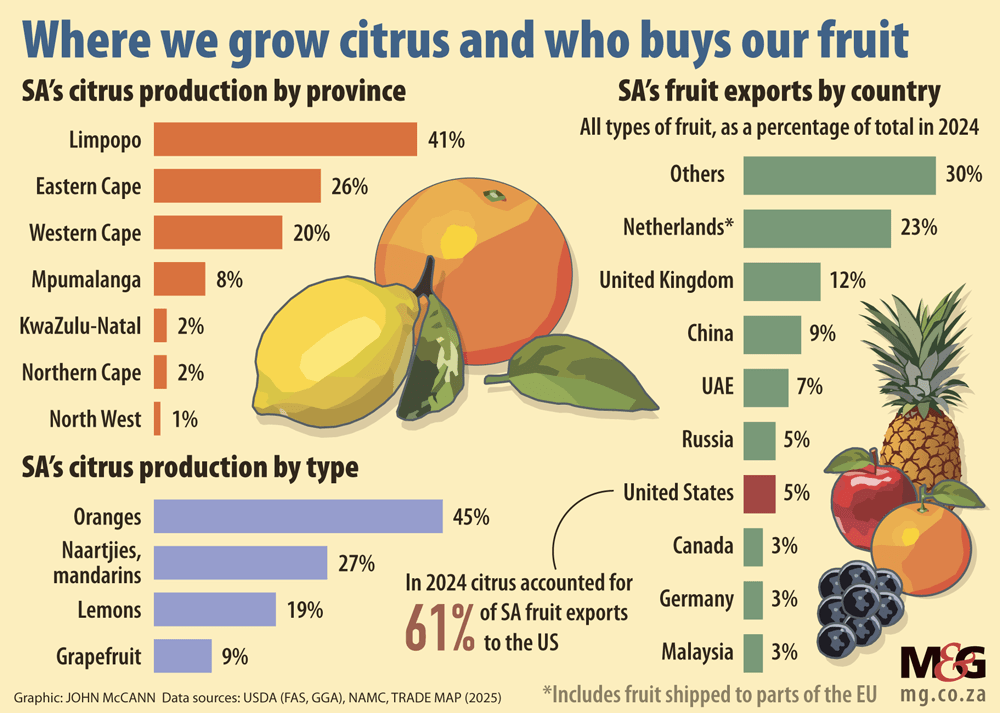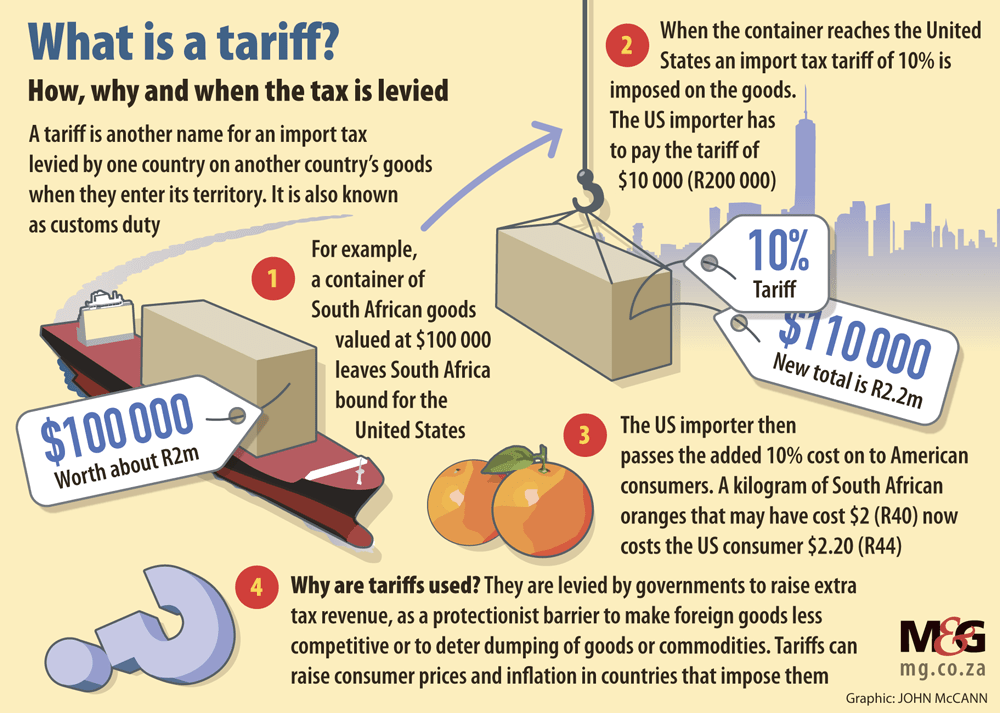As Trump tariffs kick in, SA farmers explore alternative markets

South Africa’s farmers will probably have to look for alternative markets in Africa, Asia, the European Union and among fellow Brics+ members for their produce in the face of a blanket 10% tariff on United States imports that President Donald Trump has imposed on many countries around the world.
South Africa was initially set to be slapped from Wednesday with a 30% so-called reciprocal tariff on all exports to the US — except commodities such as coal, platinum group metals, gold, manganese and chrome — under measures Trump claims are aimed at rebalancing his country’s trading relations with countries that have “ripped it off” for years.
But in a last minute about-turn Trump announced on Wednesday that he was suspending these individual reciprocal tariffs on its more than 75 trading partners, and instead applying a 10% base tariff across the board for 90 days, to allow for negotiations.
The exception was China, against which he has hiked the tariff to 125%, as a trade war between the two economic giants escalates.
Given Trump’s unpredictability, no one can confidently rule out the 30% tariffs against South Africa being back in place after three months — particularly in the light of his recent sustained attacks, including what he claims is the persecution of the white minority in the country. Ironically, the tariffs would affect a sizable number of white farmers whose interests Trump says he is championing.
A 30% tariff on South Africa would hurt local farmers who export citrus, wine, grapes and nuts to the US, said FNB senior agricultural economist Paul Makube.
“Any loss of market is negative from a farmer’s perspective. Although it is not a loss per se, the imposition of tariffs complicates the trading environment as it may increase costs, or lower revenues, as well as reduce competitiveness in the United States markets,” Makube said.
He said the trading pact under the African Growth and Opportunity Act (Agoa), which has given qualifying countries on the continent — including South Africa — duty-free access to the US market for more than 1 800 products, had effectively fallen away and the combination of price competitiveness and the exchange rate would now play a key role in determining margins.
“Obviously, SA farmers will still seek to compete in the US given the declining output out of the US,” Makube added.
The estimated value of exports to the US from South Africa’s agriculture sector was $600 million in 2024, while the total gross value of agricultural production prior to that was about R435.12 billion.
“Although accounting for just 4% of South Africa’s total exports of $13.7 billion in 2024, it [the US] is an important market from a diversification perspective with great opportunities for commodities such as citrus which has been on the decline in the US,” Makube said.
“There is still room to expand in the Asian market, which is quite huge. The Brics market is also yet to be fully explored. Further, the full implementation of the AfCFTA [African Continental Free Trade Area] will help entrench SA agriculture exports.”
He highlighted trading data showing Africa accounts for almost half of South Africa’s agriculture exports in value terms at 44%, followed by Asia at 19%, and the European Union at 21%.
The Americas account for 6%, with the US being the largest, while the rest of the world sits at 10%.
Exports to Africa totalled $13.7 billion in 2024, mainly comprising maize and related products, wheat, sugar, apples, pears, fruit juices, wine, soybean oil, sunflower oil and oil cake. “In terms of share of domestic consumption, field crops accounted for 97% with 3% destined for exports [overall], mainly maize. Horticulture accounted for 58% of domestic use while 42% was exported with citrus being the dominant commodity,” Makube said.
Ninety-five percent of animal products were for domestic consumption with 5%, mainly meat and wool, destined for world markets.
The Citrus Growers’ Association of Southern Africa (CGA) has urged the government to “prioritise immediate negotiations” with the Trump administration for tariff reductions or exemptions for citrus imports to avert substantial revenue and job losses.
Its chairperson, Gerrit van der Merwe, a farmer in the Olifants River Valley, said although South Africa exports only 5% to 6% of its citrus to the US, people in the Western Cape and Northern Cape are “heavily dependent” on the market, with 35 000 jobs being connected to US exports.
“A prime example is Citrusdal, where exports to the US form the economic heart of this vibrant town. The severity and immediate nature of the impending tariffs could mean that towns like it now face either increased unemployment or maybe even total economic collapse,” Van der Merwe said.
“There is immense anxiety in our communities.”
According to the Citrus Growers’ Association, if the 30% tariff is imposed it would make South African citrus uncompetitive — adding $4.25 to the per-carton price — especially since only a 10% tariff would be levied on its competitors who are mainly in South America.
South African citrus growers do not compete with US growers, said the association’s chief executive, Boitshoko Ntshabele.
“Our high quality produce sustains consumer interest when US local citrus is out of season,” he said, arguing that citrus should be on the tariff exemption list because it supports US health and its local industry.

According to the association, citrus exports to the US have almost doubled since 2017 to more than 6.5 million cartons and 20 000 supply chain jobs in the US are linked to the trade.
It said large volumes of citrus destined for the US would be redirected to other markets, potentially destabilising them, with a knock-on effect on the Southern African industry.
“We already face very steep tariffs with exports to promising markets like India and China. We appreciate the government’s announcement that it will intensify efforts to diversify export destinations, targeting Asia, Europe, the Middle East, to name a few — but we need to retain current markets [because] our citrus production is projected to increase substantially in the next few years,” Ntshabele said.
Increasing exports to the US is a cornerstone of the Citrus Growers’ Association’s target to create 100 000 additional jobs by 2032.
“We are now looking at a potential situation wherein not only will we be facing job losses, but we also lose the potential of serious job growth, a double tragedy,” Ntshabele said.
South Africa is the world’s largest producer of macadamia nuts and its exporters won’t walk away from one of its most promising markets, said Shane Hartman, the chief executive of Global Macadamias, which sells the nuts on world markets.
He described the US as a “critical market” for macadamia kernel exports that total R4.5 billion annually.
“Historically a consistent and stable importer, the US is well positioned to absorb increased volumes expected in the industry over the next five years. As a result, it is considered a key growth region for South Africa’s macadamia industry,” he said.
South Africa exported about $143 million worth of macadamia nuts to the US in 2023, comprising about 20% of its export market, making it the leading supplier to the US followed by Australia, Kenya, China and its own domestic production in Hawaii.
“The potential impact of the proposed 30% tariff … could be significant, with far-reaching consequences for both markets. Such a substantial tariff is too large a burden for any single stakeholder to absorb and would inevitably be shared across the value chain, from farmers and processors to retailers and ultimately, consumers,” Hartman said.
South Africa may be forced to explore alternative markets in the short term if an immediate resolution is not reached.
“However, maintaining strong trade relations with the US remains critical for long-term sustainability. The US continues to be a key growth market, and its role in the global value chain cannot be understated,” he added.
“For value adders, retailers and consumers, the primary concern lies in securing a consistent, high-quality supply. The stability of supply is vital not only for the snack and confectionery industries but also for the growing demand in sectors such as cosmetics, where macadamia oil plays an increasingly important role.
“Ensuring continued access to this strategic market is essential for the future growth and diversification of macadamias across multiple global industries.
“As we navigate the challenges ahead, we will continue to collaborate with our US customers to find mutually beneficial solutions. The industry has reaped and continues to reap significant rewards from the business generated by the US, making it essential to explore all avenues to maintain this vital partnership.”

Hartman said it was crucial for all parties to understand the repercussions on vulnerable people living in rural areas who depend on farm jobs for survival.
“By acknowledging the broader impact we are better positioned to find effective solutions that will allow us to continue trading with the US,” he said, adding that in the interim farmers could access markets in the EU, United Kingdom, Middle East and Asia.
“Both the EU and the UK have established agreements that grant South African macadamias duty-free access to their markets,” he said.
“Asia remains South Africa’s largest macadamia export market, accounting for about 40% of total exports. This significant market share highlights the potential for further growth.”
India imposes a 30% import tariff on South African macadamias but Hartman said it was still “a growing market of interest”.
“Russia presents significant potential for growth in the macadamia market, driven by its expanding economy and large population. As the economy continues to develop, the increasing demand for high-quality products, including macadamias, offers promising opportunities,” he said.
South Africa’s total wine exports were R10.3 billion, with the lion’s share of R2.6 billion headed to the UK, R971 million to Germany, R868 million to the Netherlands and R659 million in 2024, according export data from Wines of South Africa (Wosa).
Roughly 60% of South African wine is consumed locally, and the rest is exported, said Maryna Calow, the spokesperson for Wosa, which is responsible for export promotions in key international markets.
Calow said the UK and the EU were “currently collectively our strongest export markets”, accounting for 50% of exports. “Africa is definitely a growing market showing great opportunity as it is slowly maturing and has been a focus market for quite some time.”
At this stage the sector could “merely speculate” on the tariff’s effect, said Calow.
“It is also not yet confirmed that the tariff will remain at 30% as the actual reciprocal tariff for alcohol imports as matters stand should be at 25%.
“There is still a lot of clarification needed in this regard and we cannot say what is likely to happen.”
Dewald Olivier, chief executive of Red Meat Industry Services (RMIS), said South Africa does not export significant volumes of red meat to the US, mostly because of technical trade barriers.
While the full scope of the tariff adjustments announced by Trump remained unclear, any shift away from South Africa’s preferential trade access under Agoa was concerning, he said.
“The greater concern from the RMIS perspective lies in potential market spillover effects. Industries may increase their focus on alternative markets, including key red meat export destinations,” he said.
“This could create additional competition in already price-sensitive regions such as the Middle East, Asia, and Africa. Additionally, tariff developments undermine trade predictability and confidence.
“They also highlight the broader need for South Africa to diversify export markets.”
“As RMIS, we support a constructive diplomatic approach, one that recognises the importance of clear, rules-based trade and seeks to understand and address the concerns raised by the US administration.
“We also call for strengthened technical capacity within the government to respond to complex trade matters and defend South Africa’s trade position with accurate data,” he said.







